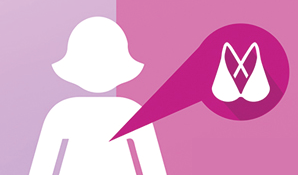For a woman (and in very rare cases, a man) a breast cancer diagnosis is a frightening experience. Breast cancer sufferers are faced with a long medical journey as well as the mental challenges of dealing with a diagnosis they hoped to never get. One of the biggest challenges of breast cancer, is not the medical battle or the emotional toll that it takes on a sufferer and her family, but the financial struggle ahead of her.
Medical costs aside, cancer also limits time, energy and earning potential, adding money worries to an already extremely stressful situation. We spoke to Dr Sarah Rayne, a specialist breast surgeon at the Helen Joseph Breast Care Clinic and Netcare Breast Care Centre, about the challenges sufferers face.
What a woman can expect in the first year after a breast cancer diagnosis?According to Dr Sarah, the first step after a lump is discovered – either in a mammogram or by a breast examination – will be to perform a biopsy. Each of these procedures are fairly simple and shouldn’t require more than a day off work for the patient. But that is just the beginning.
If the biopsy confirms cancer, the next step is a consultation with a surgeon, who will then advise about the need for surgery. A mastectomy – in which the breast is removed – or a lumpectomy – in which only the cancerous lump is removed – will require a stay in hospital, ranging from one to three days. Then, for the next three weeks after the surgery, the dressings will need to be changed every two to three days, requiring a return visit to the surgeon or hospital. On days that patients are not having the dressing changed, they will either be at home on bed rest or at work with limited physical capabilities.
Chemotherapy is usually the next step, which involves one treatment every three weeks for around six months. Chemotherapy patients usually take a week to recover from each round of treatment, leaving them able to work only two weeks out of every three. Radiation may also be prescribed either separately or as a follow-up to chemotherapy, and is usually a short daily treatment for six weeks. Radiation generally only causes slight tiredness, but requires a visit to the treatment centre each day.
Patients will then have to continue to consult with a team of doctors, including surgeons, oncologists and reconstructive surgeons, who require ongoing visits to assess progress and determine the next steps in treatment. If they have been diagnosed with a type of breast cancer that will respond to hormone treatment they will also have to return to the hospital or specialist monthly for a prescription for chronic medication for five years.
In addition, Dr Sarah points out that many women also develop the symptoms of post-traumatic stress disorder around a year after their cancer diagnosis. This will also require specialist intervention.
How much will this cost her? In private hospitals, the costs of cancer treatment are high. Each specialist appointment is usually around R1 000. Each surgery costs anywhere between R5 000 and R30 000, and each session of chemotherapy costs around R2 000. Even a follow-up visit for a dressing change costs around R300 a time. Some medical aids only cover a third of these rates, while others cover the full costs. And some medical aids don’t cover the costs of some types of reconstruction at all.
Patients in government hospitals pay significantly less for their treatment – the total bill for the year’s worth of medical intervention will cost either nothing or a few hundred rand.
However, both sets of patients will face similar challenges in dealing with the impact that cancer will have on their careers and income. All of these treatments and consultations require time off work and transport to and from specialists and hospitals – which puts a financial strain on the whole family.
South African labour law says that a person is allowed 30 days of paid sick leave over three years, but that they can take the full amount owed to them in one year. This can easily be used up in the first set of specialist consultations and surgery. This means that unless a breast cancer sufferer has an extremely sympathetic employer, the remainder of the treatment days for chemotherapy and follow-up visits will have to be taken as unpaid leave.
Cancer patients will also be too ill and tired to care for themselves or their children, so that will fall to other family members or paid help as well.
It’s clear that having cancer is very expensive and emotionally taxing.
What happens if the patient can’t cover the bills? As mentioned, many medical aids do not cover the full costs of specialist care and cancer treatment. Cancer specialists often charge three times medical aid rates, and the additional amount will not be covered by some medical aids. This means that most women who are not on comprehensive medical aid plans end up having to make large co-payments (this means that they have to pay for the shortfall). Their savings quickly run out, and some patients find that they have to go into government hospitals because they cannot afford the ongoing costs of treatment.
For low-income patients, government hospitals charge minimal fees for cancer treatment, but all the other costs, including transport and loss of earnings still apply to patients using these facilities. In a study conducted by Dr Sarah and her team, it was shown that many women struggle with the costs of getting to and from government hospitals. Some of them even abandon follow-up treatment because they struggle to take time off work or to afford the transport even though they are not paying for the treatment itself.
What can a woman do to reduce the potential financial burden of cancer? There is no question that a breast cancer diagnosis will have a significant impact on a woman’s savings and earning potential. For this reason, it is a good idea for any woman who can afford to, to take out income protection, which pays her income when she spends time away from work due to illness, and dread disease cover, which pays out a lump sum after a diagnosis that helps cover the medical costs and to make up for the time spent off work.
Women in lower income groups should at least have a hospital cash-back plan, which will allow them to receive a cash payout for every day that they are in hospital. They can also apply to government for a temporary disability grant if they are unable to work for the course of their treatment.
But, as Dr Sarah points out, a woman’s treatment and recovery will be greatly helped by supportive friends, family and employers – so if you know someone facing this daunting challenge, be aware that you can play a role in making their journey much easier just by understanding and being there.
_________________





